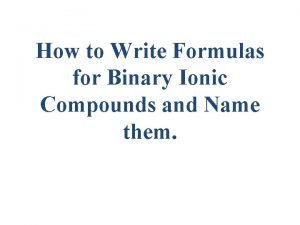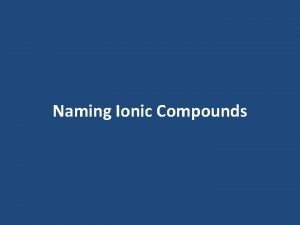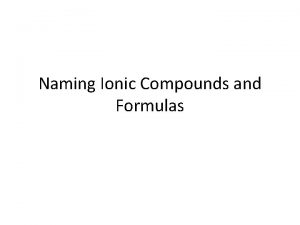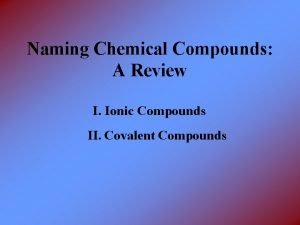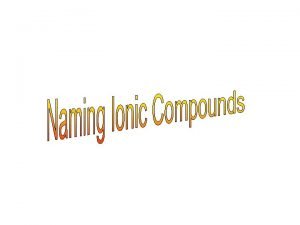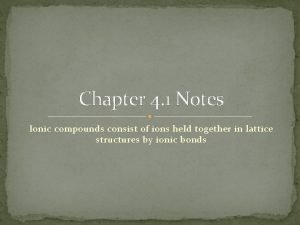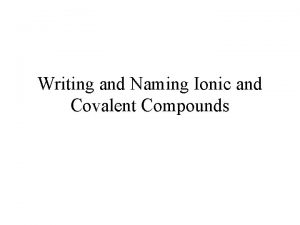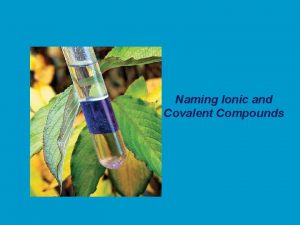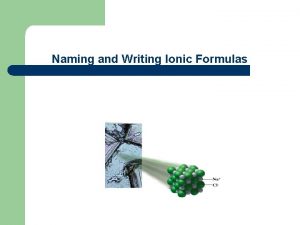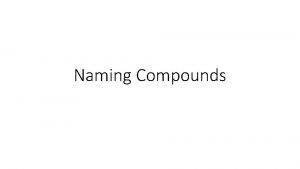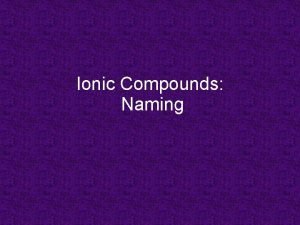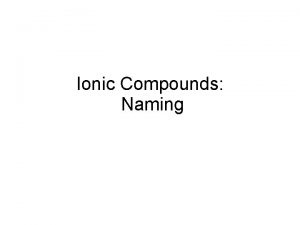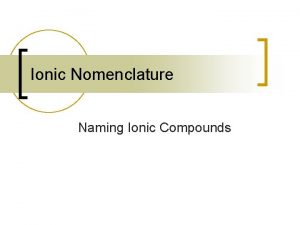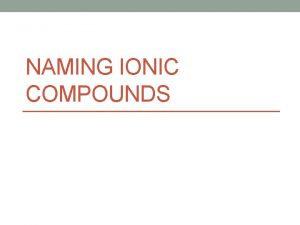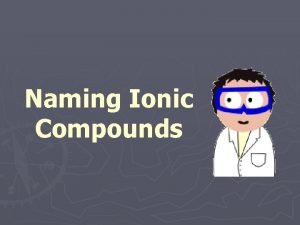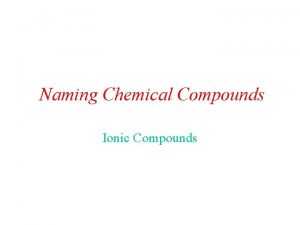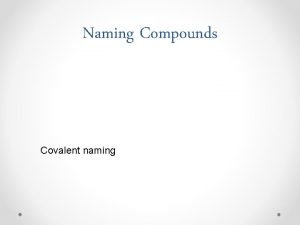Topic Naming Ionic Compounds Do Now Write formulas














- Slides: 14

Topic: Naming Ionic Compounds Do Now: Write formulas for the following 1. Na and Cl 2. Mg and I 3. Al and S Na+1 Cl-1 = Na. Cl Mg+2 I-1 = Mg. I 2 Al+3 S-2 = Al 2 S 3

Naming Binary Ionic Compounds there is a flow chart for you to use add to your reference table packet 1. Always name metal (the cation/+ ion) first 2. Leave a space 3. Write stem of nonmetal (the anion/ - ion) and Add ending “ide” to nonmetal Binary = only 2 types of elements (two capital letters)

Stems of nonmetals Nitr Ox Fluor Phosph Sulf Chlor Arsen Selen Brom Hydr is the stem for H Tellur Iod

Metals with one oxidation state • • Ca. O Calcium Oxide Ba. S Barium Sulfide Al. N Aluminum Nitride Li. Cl Lithium Chloride Al 2 Se 3 Aluminum Selenide Na 2 O Sodium Oxide K 3 N Potassium Nitride Mg. F 2 Magnesium Fluoride

The First Step in Naming • Find metal on PT • If metal has only one oxidation state it’s easy • If metal has more than one oxidation state, there’s an extra step

Metals with more than 1 oxidation state • Use formula to figure out which oxidation state metal ion has • Ex: Fe can be Fe+2 or Fe+3 » Fe. O vs Fe 2 O 3 – two different compounds so cannot both be called iron oxide – so we have to use Roman Numeral to Tell which Fe (Fe+2 or Fe+3) we are using – Iron (II) Oxide –uses Fe+2 – Irons (III) Oxide – use Fe+3

When deterring Oxidation State of Metal being used, assigned the nonmetal it’s oxidation number first (will be the top oxidation number from the PT)

Fe. O • Compounds are electrically neutral • Oxygen is -2 Fe. O 1 O which is -2 so Fe must be +2 Name: Iron (II) oxide but means Iron (+2) Oxide (roman numeral II = charge on Fe is +2)

Fe. O and Fe 2 O 3 Each O is -2 Each Fe is +3 Fe 2 O 3 There are 3 O’s 3 X (-2) = -6 Total negative charge Name: Iron (III) oxide but means Iron (+3) Oxide Total positive charge must be +6 (roman numeral III = charge on Fe is +3)

Name the following • • Ti. Cl 3 Titanium (III) chloride Mn. O 2 Manganese (IV) oxide Co 2 O 3 Cobalt (III) oxide Pd. Br 2 Palladium (II) bromide Au. Cl 3 Gold (III) chloride Mo. N Molybdenum (III) nitride Mn. O Manganese (II) oxide Ti. O Titanium (II) oxide

Summary for Binary Ionic Compounds are electrically neutral • Formula: positive first • If metal has more than 1 oxidation state, name has roman numeral (MOST ALL TRANSITION METALS need this) • Name = metal + stem of nonmetal + ide

Some ionic compounds have a polyatomic ion – see table E EXAMPLE KOH - K = metal (positive ion) and OH = polyatomic ion (negative ion) Mg. SO 4 – Mg = metal (positive ion) and SO 4 = polyatomic ion (negative ion)

Naming compounds with polyatomics • • polyatomic ions have names (Table E) naming is parallel to binary naming positive always written first if (+)’ve ion is a metal, check to see how many oxidation states it has – if > 1 then name must have roman numeral • if (–)’ve is polyatomic - 2 nd part of name is name of polyatomic (don’t modify ending)

Name the following • • Na. OH Sodium hydroxide KHCO 3 Potassium hydrogen carbonate Li. NO 3 Lithium nitrate Ca. SO 4 Calcium sulfate Al(NO 3)3 Aluminum nitrate Fe(OH)2 Iron (II) hydroxide Cu. SO 4 Copper (II) sulfate Cu. SCN Copper (I) thiocyanate
 Monatomic ion definition chemistry
Monatomic ion definition chemistry Ag3po4compound name
Ag3po4compound name Bunary compound
Bunary compound Cl-1 ion name
Cl-1 ion name How do you name an ionic compound
How do you name an ionic compound How to name ionic compounds
How to name ionic compounds Naming binary ionic compounds
Naming binary ionic compounds Concept 2 notes naming ionic compounds
Concept 2 notes naming ionic compounds Writing chemical formulas criss cross method
Writing chemical formulas criss cross method Flowchart for naming binary compounds
Flowchart for naming binary compounds Heptaphosphorus
Heptaphosphorus Carbon tetrabromide ionic or covalent
Carbon tetrabromide ionic or covalent Churomium
Churomium Naming binary compounds ionic
Naming binary compounds ionic Naming binary ionic compounds
Naming binary ionic compounds


